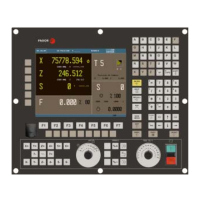·96·
Installation manual
CNC 8055
CNC 8055i
2.
CNC 8055 I CONFIGURATION
SOFT: V02.2X
CNC structure
CAN I/Os - Expansion of inputs and outputs (remote I/O)
The CAN bus connection allows connecting up to 4 remote modules to the central unit to expand
the number of digital or analog inputs and outputs,
The transmission speed depends on the length of the cable or total CAN connection distance.
Machine parameter IOCANSPE (P88) must be set.
Module identification at the bus.
Each one of the elements integrated into the CAN bus is identified by the 16-position rotary switch
(0-15) "Address" (also referred to as "Node_Select"). This rotary switch selects the address (node)
occupied by each element integrated in the bus.
The CNC's communications board does not have a switch and always assumes position 0 inside
the bus. The rest of the modules occupy consecutive positions starting from ·1·.
The "Line_Term" switch.
The "Line_Term" switch identifies which are the elements that occupy the ends of the CAN bus; i.e.
the first and last physical element in the connection.
The switch of the elements at the ends must be in the "1" position and the rest of the elements in
the "0" position.
The central unit must always be at one end of the line. The other end will be the last one of the remote
module groups.
The CNC does not have a "Line_Term" switch and always has the terminating resistor activated.
CAN connector pinout.
5-pin male Phoenix minicombicon connector (3.5 mm pitch).
The connector has two shield pins. Both pins are equivalent; the CAN shield may be connected to
either one.
Although both CAN buses are independent, the CAN addresses of the drives cannot be the same as
the CAN addresses of the I/O modules. If address ·1· is used at the drive's CAN bus, there cannot
be any module with that address in the CAN bus of the I/O's.
Signal Description
ISO GND Ground / 0 V
CAN L Bus signal (LOW)
SHIELD CAN shield
CAN H Bus signal (HIGH)
SHIELD CAN shield
CAN L
SHIELD
CAN H
SHIELD
ISO GND
1
2
3
4
5
1
2
3
4
5
Pin Pin

